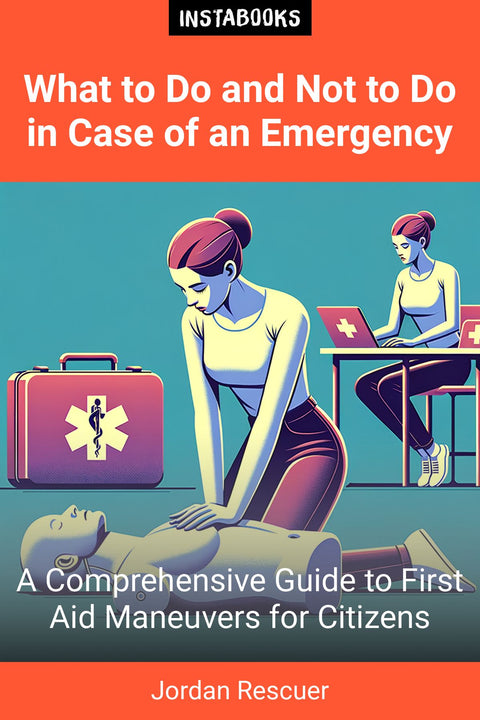
What to Do and Not to Do in Case of an Emergency
A Comprehensive Guide to First Aid Maneuvers for Citizens
Included:
✓ 200+ Page AI-Generated Book
✓ ePub eBook File — read on Kindle & Apple Books
✓ PDF Print File (Easy Printing)
✓ Word DOCX File (Easy Editing)
✓ Hi-Res Print-Ready Book Cover (No Logo Watermark)
✓ Full Commercial Use Rights — keep 100% of royalties
✓ Publish under your own Author Name
✓ Sell on Amazon KDP, IngramSpark, Lulu, Blurb & Gumroad to millions of readers worldwide
Introduction
In today's fast-paced world, emergencies can occur at any time and often when least expected. Knowing how to respond effectively can mean the difference between life and death. "What to Do and Not to Do in Case of an Emergency" is a vital resource designed to empower citizens with the essential knowledge and practical skills required to handle medical emergencies while waiting for professional assistance.
Alerting Emergency Services
Understanding how to alert emergency services is the first step in providing effective assistance. This book dives deep into the critical information you need to relay about the situation, including precise details about the accident location, the number of people involved, and their state of health. Effective communication is key in these moments, and we will equip you with the tools to convey necessary information clearly and succinctly to emergency responders.
Recognizing Medical Emergencies
Not every injury is straightforward. Learn how to assess the scene, identify potential hazards, and gather invaluable information about the injured person’s vital signs and physical condition. We will cover how to spot signs of life-threatening ailments and ensure the safety of both the rescuer and the victim.
Sustaining Vital Functions
Mastering basic first aid techniques is crucial, especially methods for sustaining vital functions. From assessing the airway to administering CPR, this book provides detailed instructions to ensure you can respond effectively to a range of issues—be it a fainting episode, an asthma attack, or severe bleeding.
Addressing Workplace Traumas
With increasing incidents occurring in various jobs, knowledge of how to manage workplace injuries is essential. This book discusses the anatomy of the skeletal system, how to identify fractures and dislocations, as well as how to respond to head and spinal injuries. Each closed chapter provides a robust understanding of trauma in various environments.
Dealing with Chemical Exposures
As chemical exposure incidents can occur unexpectedly, this guide includes methodologies for dealing with injuries caused by chemicals, extreme temperatures, or electric shocks. Through practical examples, you'll learn how to act quickly and efficiently to mitigate the situation.
Conclusion
What to Do and Not to Do in Case of an Emergency is not just a book; it's an essential manual for living empowered, equipped to make a real difference in life-threatening situations. Whether you're at home, in public, or at work, this book will prepare you for the unpredictable, ensuring that when help is minutes away, you can be the difference between life and death.
Table of Contents
1. The Importance of First Aid Training- Why Every Citizen Should Be Prepared
- Understanding Emergencies
- First Aid Training Resources
2. Alerting Emergency Services
- Gathering Essential Information
- Effective Communication Techniques
- Knowing When to Call for Help
3. Recognizing Medical Emergencies
- Signs of Critical Conditions
- Assessing the Scene for Hazards
- Gathering Patient Information
4. Sustaining Vital Functions
- The ABCs of First Aid
- Administering CPR Properly
- Understanding Choking Relief Techniques
5. First Aid for Fainting and Seizures
- Recognizing Fainting Episodes
- Managing Seizures Safely
- Post-Episode Care
6. Dealing with Respiratory Emergencies
- Identifying Asthma Attacks
- Using Inhalers Effectively
- Supporting Breathing in Emergencies
7. Managing External Bleeding
- Controlling Bleeding Techniques
- When to Use a Tourniquet
- Wound Care Basics
8. Understanding Workplace Injuries
- Recognizing Common Injuries
- Basic Skeletal Anatomy Overview
- First Aid for Fractures and Sprains
9. Responding to Chemical Exposures
- Identifying Chemical Hazards
- First Aid Procedures for Chemical Burns
- Dealing with Poisoning Cases
10. Handling Heat and Cold Injuries
- Identifying Heatstroke and Hypothermia
- First Aid Responses
- Long-Term Precautions
11. Practical First Aid Communication Techniques
- How to Speak with Emergency Operators
- Using Clear and Calm Communication
- What Information is Most Important?
12. Hands-On Practice Techniques
- Real-Life Scenarios for First Aid Practice
- Simulated Emergency Response Drills
- Reviewing Key Concepts and Best Practices
Target Audience
This book is written for everyday citizens who want to enhance their skills in emergency response and first aid, ensuring they can help effectively before professional help arrives.
Key Takeaways
- Essential skills for handling emergencies effectively.
- Clear guidelines for alerting emergency services and communicating vital information.
- Detailed first aid procedures for various medical emergencies.
- Knowledge of workplace trauma management.
- Guidance on recognizing and responding to chemical exposures.
- Practical techniques for hands-on first aid interventions.
